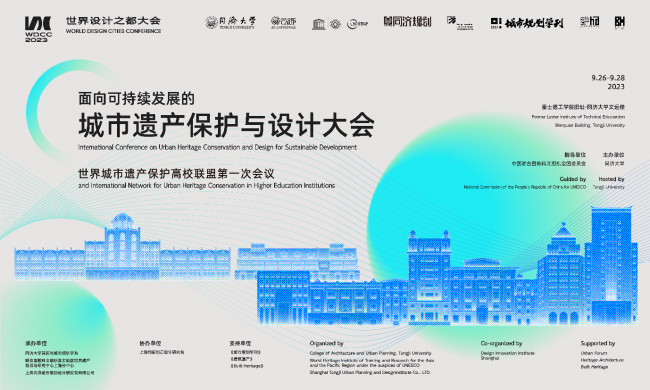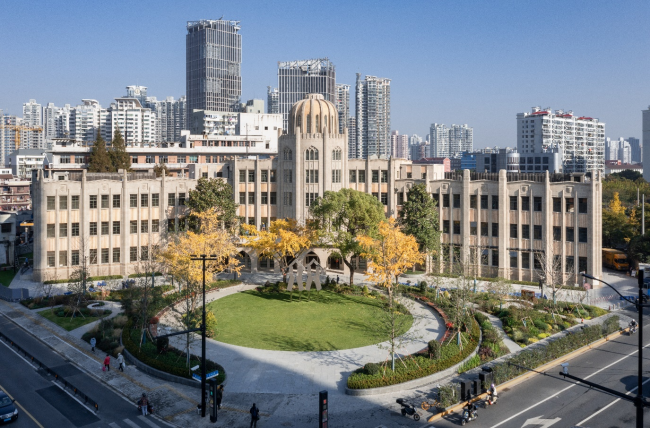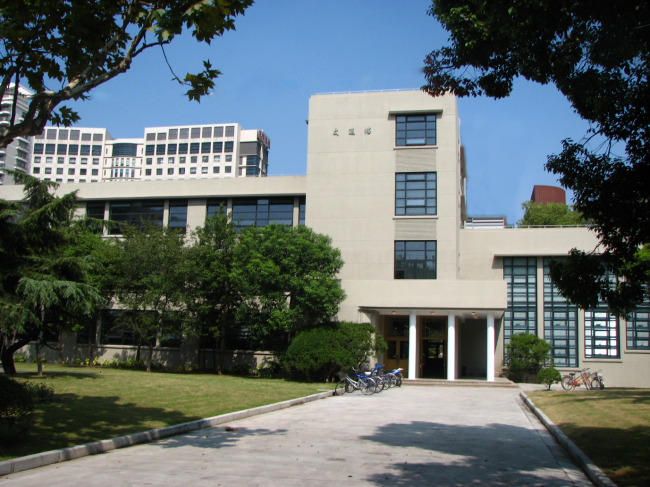| International Conference on Urban Heritage Conservation and Design for Sustainable Development And International Network for Urban Heritage Conservation in Higher Education Institutions |
| PublishDate:2023-09-15 Hits:5403 |
 Time: September 26-28, 2023
Venue: Former Lester Institute of Technical Education,
Wenyuan Building (3rd Floor), Tongji University,
ZOOM
On 26 to 28 September 2023, Tongji University, as host, together with the College of Architecture and Urban Planning (CAUP), World Heritage Institute of Training and Research for the Asia and Pacific Region, a Category 2 Centre under the auspices of UNESCO (WHITRAP Shanghai), and Shanghai Tongji Urban Planning and Design Institute Co., LTD. are co-organizing an International Conference on Urban Heritage Conservation and Design for Sustainable Development and holding the first International Network for Urban Heritage Conservation in Higher Education Institutions' meeting. This Conference is a follow up to WHITRAP Shanghai and CAUP of Tongji University's endeavors to promote the UNESCO 2011 Recommendation on the Historic Urban Landscape approach (HUL) and its 2022 activities. Last year, they celebrated three important events: the 50th Anniversary of the World Heritage Convention; the 40th Anniversary of China’s National Famous Historical and Cultural Cities Protection System; the 70th Anniversary of CAUP Tongji University and the Tongji Planning Centennial. These events were commemorated by organizing a series of six “WHITRAP Shanghai World Heritage Dialogues” and an international conference on “World Heritage and Urban-Rural Sustainable Development: Resilience and Innovation based on Humanity”. These events brought together high-level specialists from the Asia-Pacific region and around the world to provide cutting-edge professional information and expert perspectives on heritage conservation and its role in contemporary society. Among the key outcomes of the discussions held in these events, and in particular at the “Asia and Pacific Shanghai Initiative for Urban-Rural Heritage”, participants highlighted the need to strengthen interdisciplinary research, promote competency building as well as acknowledge the crucial role of traditional knowledge, and develop competency frameworks through knowledge sharing and best practices. These conclusions resonate with previous findings: in the area of heritage and urban development, the lack of competency and capacity at all levels is constantly highlighted by UN Organisations, in international summits and committees such as the World Heritage Committee as priority challenges to be urgently addressed. The 26-28 September International Conference and the setting up of a Network will address these challenges. The aim of both initiatives is to further reflect on competency building and to explore how new talents and innovative approaches can be built to integrate heritage conservation and development. Ultimately, and in line with the long-term goals of education, they share a vision of improving contemporary urban, architectural and landscape design in fast-growing cities and evolving rural settlements. This two-day conference is divided into three thematic sessions, including 1) Interdisciplinary Research: Implementing the UNESCO Historic Urban Landscape approach, theory and practice.; 2) Innovative Practice: Urban conservation for improving livability; and 3) a workshop on Higher Education towards Sustainable Development Goals. In addition to the keynote presentations and speeches to be made in each session, three parallel sub-forums will be held in the afternoon session of 27 September to discuss the topic of "Heritage and Education", which will eventually lead to a common "Initiative" to be published in the end of the conference. The International Conference and the first Network meeting intends to be held during the annual Shanghai 2023 World Design Cities Conference (WDCC), as a confluence of events that share a common approach to linking new approaches to design and heritage. The WDCC is organized within the framework of Shanghai’s UNESCO Creative City of Design activities, promoted by the Shanghai Municipality. As a Creative City of Design, Shanghai aims to strengthen the exchanges on the creation, production, distribution, and enjoyment of cultural goods and services between Cities of Design and other creative fields of the UCCN as well as to develop initiatives linking design and folk arts to demonstrate the importance of combining modern design and cultural heritage. Language The conference will be bilingual with simultaneous interpretation. A brief synthesis will be published online on the WHIRTAP website. Agenda Outline Afternoon of 26 September (14:30-18:00 and 19:00-22:00 Beijing Time) 14:30-15:30 Opening Ceremony 14:30-15:05 Opening Speeches 15:05-15:30 Group Photo (online and offline) and tea break 15:30-18:00 6 Keynote Speeches 18:00-19:00 Dinner 19:00-22:30 Topic 1: Interdisciplinary Research: Implementing the UNESCO Historic Urban Landscape approach, theory and practice 19:00-19:05 Introduction 19:05-20:35 6 presentations 20:35-20:45 Group photo and tea break 20:45-22:20 6 presentations 22:20-22:30 Wrap-up 27 Sep (9:00-12:30, 14:30-17:30, 19:00-22:00 Beijing Time) 09:00-12:30 Topic 2: Innovative Practice: Urban conservation for improving liveability 09:00-09:05 Introduction 09:05-10:35 6 presentations 10:35-10:50 Online and offline group photo + coffee break 10:50-12:20 6 presentations 12:20-12:30 Wrap-up 12:30-14:30 Lunch Break 14:30-18:30 Topic3: Workshop on Higher Education towards Sustainable Development Goals and establishment of the “World Urban Heritage Conservation University Network" 14:30-14:40 Introduction 14:40-15:00 Presentation of participants and working method and group photo online and offline 15:00-17:00 Three thematic parallel working group sessions (online and offline) Theme 1: Research Theme 2: Education Theme 3: Action 17:00-17:30 Presentation of the results of the three thematic sessions 17:30-18:25 Discussion and drafting of the key outcomes 18:25-18:30 Wrap up 18:30-20:00 Dinner 20:00-21:00 Closing Ceremony 20:00-20:05 Closing speeches 20:05-20:25 Summary of the three sessions 20:25-20:55 Presentation of the “World Urban Heritage University Network Initiative” 20:55-21:00 Closure Venue Former Lester Institute of Technical Education In 1934, the Henry Lester Institute of Technical Education, established through a donation by the British architect, real estate tycoon and philanthropist Henry Lester, was completed in Shanghai. It was built in the style of British Gothic Revival and Art Deco, and quickly became one of the top engineering institutions in Shanghai. Over the course of its first decade, it nurtured a remarkable group of talents in China. In 2021, this near-century-old historical building became the venue for the inaugural "Design Universe" creative camp of Design Innovation Institute Shanghai, marking the beginning of its rejuvenation to be led by the North Bund Group. By early 2023, after extensive renovations, the iconic Lester building was transformed into a world-class design innovation hub under DIIS’s operation, launching a new chapter that bridges history and the future.
 Wen Yuan Building Wenyuan Building, located in the campus of Tongji University, was built in 1953, with a total floor area of 5,050 square metres. It also serves as the seat of WHITRAP Shanghai. Wenyuan Building is a reinforced concrete structure with western modern architectural design and traditional Chinese elements. The structure was listed as a municipal-level protected building in Shanghai in 1994, and was awarded the bronze medal of "Shanghai Classic Architecture in 50 Years of New China" in October 1999, and was awarded the bronze medal of "Shanghai Classical Architecture in 50 Years of New China". The Building exemplies the designer's deep understanding of the spirit of modern architecture, expressed not only by the modern architectural techniques applied in the construction, but also the employment of these modern ideas into the concept, the spatial and functional layouts and the design of components and details. Wenyuan Building represents one of the most important masterpieces of the earliest modern buildings after the founding of New China. As one of the important witnesses tp the architectural activities in the early period of the founding of PRC, it is of great value to the study of the development and history of modern architecture in China.
|
|
|
- WHITRAP's Side Event Adopted by the 46th Session of WH Committee
- Publication | WHITRAP Newsletter No. 62
- News | HeritAP Chat: 2024 World Heritage Contribution to Sustainable Development Goals Successfully Held
- SEAMEO SPAFA-WHITRAP Training Workshop on Heritage Impact Assessment held in Melaka
- Call for Application | 2024 Global Awards for World Heritage Education Innovative Cases(AWHEIC) Promoting what people do and how they do it
- Documentary: 2023 World Heritage Creative X Innovators Conference and the AWHEIC Third Anniversary Celebration
Copyright © 2009-2012 World Heritage Institute of Training and Research-Asia and Pacific (shanghai)



